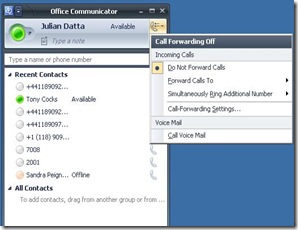My Demo Environment - Part 3 Integrating Exchange 2007 UM with OCS
So far I have tried to highlight how to get OCS and UM working separately. But obviously if we can integrate these two products together the user experience just gets better.
For instance you can:-
Call Voicemail from Communicator
See missed call notifications
No longer have to remember authentication details for OVA
The bottom line is Exchange 2007 now becomes the Voicemail system for OCS 2007. This means that essentially I can have a software based VOIP system integrated with a software based voicemail system. Obviously Exchange and OCS are much more than just that, hopefully you can start to see how Microsoft is unifying these communications so that they are totally integrated and beneficial to each other.
What do you need
1. Upgrade the Exchange server to sp1
2. Once done you will need to configure a new dialplan - using powershell
New-umdialplan - name OCSUMDailPlan -Uritype "Sipname" -Voipsecurity "SipSecured" - Numberofdigitsinextension 4
I then went into the properties of this dialplan and set the subscriber access number (this will be different for users just using ordinary Outlook Voice Access)
3. Apply this dialplan to the UM server
set-umserver -id Umdemo -dialplans OCSUMDialPlan
What I have done so far is create a new dialplan and assign it to the server.
The Dialplan will also automatically create a UM Mailbox policy so check what this has been called.
4. Then run ps1 script that is given in the Exchange 2007 sp1 binaries - it is called exchucutil.ps1. This is found in the scripts folder.
There is a great explanation of what it does here
I had a few issues running this originally - I got around the issue by changing the path to the scripts folder - no doubt this is something to do with my paths but I will figure that out later
This will create a umipgateway.
5. Next run OCSumutil - I did this on my OCS server - with the line ocsumutil /domain:ucdemo.com
What this does is create a RTC Special Accounts container in AD. In this container it will add a contact, I need to do a bit more investigation and work out the flows but I believe that when a call is diverted to voice mail it is this contact that is looked up and used to forward the call. The reason I say this is because the Line URI and telephone number are the subscriber access number that we gave in Step 2
6. Enable the users. This can be done via the GUI or Powershell, if done via the GUI pick the mailbox policy that was created for the dialplan - this will ensure that a SIPResourceidentifier is required, give this and the extension and enable the account. Alternatively the following powershell command will work
Enable-Ummailbox -id Julian -ummailboxpolicy "OCSUMDialplan Mailbox Policy" -extensions 2003 -sipresourceidentifier julian@ucdemo.com
This should then allow you to connect to your voice mail form communicator and also give you the options to redirect incoming calls to voice mail - see screen shots below
So this all worked for me but other things that may cause issues if it does not work first time is certificates. OCS needs to trust UM so you may need to get a certificate to allow this. To do this in powershell
New-ExchangeCertificate -DomainName ucdemo.com -Friendlyname UMOCSCert -Generaterequest:$True -Keysize 1024 -path c:\umocscert.req - privatekeyexportable:$true -subjectname "c=GB, o=Berkshire, cn=umdemo.ucdemo.com" -force:$true
So this will generate the cert request - take this and go to your certsrv https://server/certsrv and run through requesting a cert
Once you have it import it back to the exchange server
Import-ExchangeCertificate -Path c:\requestedcert.cer | Enable-ExchangeCertificate -ServicesUM


